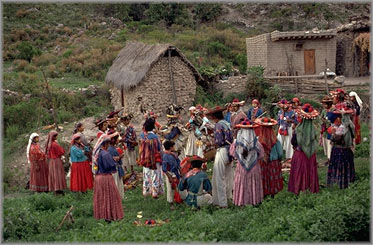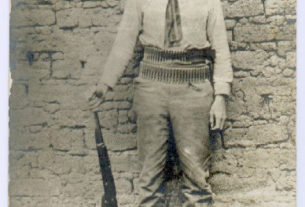Mexican History
I don’t like flying; or rather it’s the going up and the coming down that bothers me most. Once I’m in the air and realize there is nothing I can do about it, I become quite philosophical about it all and try to forget my good friend John Hindmarsh, a skilled pilot, who for no apparent reason crashed and was killed in a field near my hometown of Goderich, Ontario. After that, I swore I would never go up in a single engine plane, commercial jet planes were bad enough.

Never say “never.” Years later, I found myself at a Huichol Peyote Fiesta at Las Guayabas in the Huichol sierra at the invitation of some Huichol friends.
Las Guayabas lay in a deep valley below the plateau of San Andrés Cohamiata in Mezquitic, Jalisco, Mexico. I had arranged with some other friends who remained behind in San Andrés to return to Guadalajara with them by car after the ceremonies. They had decided that the three and a half hour trek from the plateau down to the village was not for them and so they did not attend the event. The Peyote Fiesta over, I waited patiently — or so I thought. My Huichol friends assured me that they would soon be going back up the mountain to San Andrés. I waited. When nothing happened, I began to realize that I was living in Indian time and if I hoped to get a ride back home, I would have to make my own way out. So I set out on foot alone to find my way through the woods and back up the long trail to San Andrés.
I arrived too late. My friends had apparently given up on me and left without me. On the day I arrived back in San Andrés, I could not find any of my other Huichol friends in the pueblo. I made my way to the only store in town and asked for a soft drink. The little Huichol girl who served me murmured in dark undertones, “gringo.”
Without my influential friends back in Las Guayabas, I knew I had already worn out my welcome in San Andrés. I learned later that uninvited strangers are simply asked to leave. As an additional incentive to get out, the Huichols may refuse to sell you anything to eat or drink. I noticed several large rugged delivery trucks nearby and asked one of the drivers if I could get a ride back to Huejuquilla, the nearest big pueblo outside of San Andrés in the Huichol Sierra. He quoted me 1,500 pesos but no one was willing to drive me out even at that price.
I wandered out of town toward the rock-strewn single runway landing strip of San Andrés. Several Huichols were gathered at the side of the field with stacks of cardboard boxes beside them. They told me that the regular flight from Tepic was not due for several days, but that a single engine light aircraft was scheduled to arrive in a few hours. I checked my wallet and decided to throw myself on the mercy of the pilot, whoever he was, and offer him the few hundred pesos I had left for a flight out of the Huichol territory.
The plane finally did arrive and so did all my old fears of flying. The flimsy craft bounced and slid over the rough gravel runway. The pencil-thin wheel struts seemed about to break off with the force of the landing as the plane lurched to a stop, wings flapping like a wounded duck. The tiny door to the cockpit opened but the pilot never even got out. One Huichol opened the door on the passenger side, while another began to pile cardboard boxes inside. I managed to get the pilot’s attention and he agreed to take me to Pochitatan, where I could catch a bus to Tepic and from there to Guadalajara. I figured I would have just about enough money left for the bus fare if I didn’t eat for the next few days.
The men finished loading the boxes into the plane. I didn’t see how they could pack in much more, when three burly Huichols pushed through the tiny side door into the plane. I managed to squeeze myself into the last vacant space at the tail end, my feet up on cardboard boxes. The inside of the cabin where I sat was so small I could touch both sides of the plane with my elbows. The sides of the plane seemed to bulge outwards as the pilot revved up the engine and prepared for take-off. The cardboard-thin sides of the papier-mache plane began to shudder and shake as we bounced over the rough gravel runway. Just as it seemed the matchstick wheel struts were about to break off, we were in the air and over the edge of the great plateau.
Except for the line of large trees that skirted the mountain stream from which the Huichols get their drinking water, Las Guayabas was all but lost in the deep valley below. Beyond us stretched a deep cleft in the mountains, the size of which would have dwarfed the Grand Canyon. From my vantage point, I could see an endless array of rugged mountain peaks, deep valleys, and here and there a lake or a winding river. I felt as if I were sitting in a very small bathtub out of which I could see both sides without even turning my head. But instead of the safety of the bathroom floor under my feet I was looking down several thousand feet into a terrain so rugged that Cortes and his entire band of Conquistadores would have got discouraged.
My confidence was further shaken when a pesky fly began buzzing around inside the narrow confines of the cockpit. The pilot reached under his seat and pulled out a sturdy flyswatter and began to swat vigorously at the intruder fly. Each time he thwacked at the fly on the paper-thin walls of the aircraft I held my breath waiting for a seam to burst sending us plunging headlong into one of the profoundly deep abysses below. I was greatly relieved when the pilot finally succeeded in dispatching the unwanted air traveler.
While I was holding grimly on to my seat and praying for the end of the flight, the pilot and his Huichol passengers were chatting gaily away about a recent soccer game. When they finally decided to include me in their conversation I was forced to admit that I was too scared to pay much attention to their conversation. They all laughed at me and resumed their casual chatter. I decided to keep quiet the rest of the trip.
I was just beginning to relax a little when the pilot calmly announced that he was going to save gas by shutting off the motor and drifting on the strong air currents between two particularly menacing mountain peaks. We skirted so close to the ground I could make out the leaves on the trees as we passed over. The silence was deafening. I prayed for the sound of the motor once again. Just as I convinced myself that we were going down for the last time, the pilot turned the key and the motor revved up again. I was never so thankful to hear the sound of a noisy engine.
Suddenly the pilot announced that we were going to land. In vain I scanned the landscape below for a landing strip. Then I spied it, a narrow strip of cleared land running along the very edge of a beetling mountain ridge. A few scattered buildings lay at one end of the pathway but we weren’t even heading in that direction — or so I thought. Suddenly, without the slightest warning, the plane banked, reversed directions, and dropped abruptly in the direction of the thin strip of cleared ground. I left my stomach somewhere in the upper atmosphere.
Miraculously, the pilot found his mark and in a matter of seconds we were bouncing along a narrow gravel trail just wide enough for the plane. We taxied to the end of the makeshift runway, turned, and started back. Several people were waiting at the other end. The pilot paused, motor still running, only long enough for one of men to jump out of the plane while another took his place immediately. A roar of the engine and we were plunging off the mountain ridge and soaring over the valley below. The whole operation took only a few minutes.
We continued our flight toward Pochitatan, a pueblo just on the outskirts of the Huichol sierra.The pilot warned me to expect a hostile reception by army troops searching for drugs and guns for, while it was legal for the Huichols to take peyote into their territory, it was illegal to bring any out. Sure enough, upon landing we were immediately surrounded by grim-faced soldiers brandishing sub-machine guns. While I was extracting myself from my flying coffin, the soldiers searched the boxes, which contained yarn paintings, beaded masks, and other arts and crafts for sale in Tepic and Guadalajara. The soldiers then turned their attention to me. I awaited my fate as I brought out my backboard to be searched. Instead a very young soldier stepped forward and in a faltering voice tried out a few words of English. I congratulated him on his English and told him I had taught English in Ajijic and Mismaloya at Lake Chapala. Suddenly the mood changed. All the soldiers, it seemed, were anxious to learn English. There by the side of the plane we had a brief impromptu English class. Finally, the soldiers thanked me and directed me toward the Pochitatan bus, where, I was told, I could make connections for Guadalajara via Tepic.
All things are not as they seem in Mexico. Scratch the surface and underneath you will find the “Unknown Mexico” that the Norwegian naturalist-explorer-anthropologist Carl Lumholtz wrote about over a hundred years ago.
Part 7 of a seven part series
- Personal reminiscences of Mexico’s Huichol people I: a disappearing way of life?
- Personal reminiscences of Mexico’s Huichol people II: fiesta of medicinal plants
- Personal reminiscences of Mexico’s Huichol people III: the shaman
- Personal reminiscences of Mexico’s Huichol people IV: ritual dance
- Personal reminiscences of Mexico’s Huichol people V: journey to the sierra
- Personal reminiscences of Mexico’s Huichol people VI: Peyote Fiesta
- Personal reminiscences of Mexico’s Huichol people VII: return from the Huichol sierra

